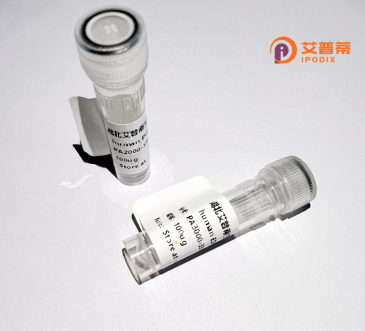
| 纯度 | >90%SDS-PAGE. |
| 种属 | Human |
| 靶点 | WBSCR1 |
| Uniprot No | Q15056 |
| 内毒素 | < 0.01EU/μg |
| 表达宿主 | E.coli |
| 表达区间 | 2-248 aa |
| 活性数据 | ADFDTYDDR AYSSFGGGRG SRGSAGGHGS RSQKELPTEP PYTAYVGNLP FNTVQGDIDA IFKDLSIRSV RLVRDKDTDK FKGFCYVEFD EVDSLKEALT YDGALLGDRS LRVDIAEGRK QDKGGFGFRK GGPDDRGMGS SRESRGGWDS RDDFNSGFRD DFLGGRGGSR PGDRRTGPPM GSRFRDGPPL RGSNMDFREP TEEERAQRPR LQLKPRTVAT PLNQVANPNS AIFGGARPRE EVVQKEQE |
| 分子量 | 27.3 kDa |
| 蛋白标签 | His tag N-Terminus |
| 缓冲液 | PBS, pH7.4, containing 0.01% SKL, 1mM DTT, 5% Trehalose and Proclin300. |
| 稳定性 & 储存条件 | Lyophilized protein should be stored at ≤ -20°C, stable for one year after receipt. Reconstituted protein solution can be stored at 2-8°C for 2-7 days. Aliquots of reconstituted samples are stable at ≤ -20°C for 3 months. |
| 复溶 | Always centrifuge tubes before opening.Do not mix by vortex or pipetting. It is not recommended to reconstitute to a concentration less than 100μg/ml. Dissolve the lyophilized protein in distilled water. Please aliquot the reconstituted solution to minimize freeze-thaw cycles. |
1. **"WBSCR1. a protein implicated in Williams-Beuren syndrome, interacts with the chromatin remodeling complex B-WICH"**
*Authors: M. Peregrín-Alvarez et al.*
摘要:研究揭示WBSCR1通过与B-WICH复合物(包含SNF2H和核仁蛋白)相互作用,参与染色质重塑和核糖体DNA转录调控,可能解释威廉姆斯综合征中神经发育异常的机制。
2. **"The Williams syndrome transcription factor TFII-I regulates cardiovascular development through interaction with WBSCR1"**
*Authors: K. Yoshida et al.*
摘要:发现WBSCR1与转录因子TFII-I形成功能复合物,共同调控心脏和血管发育相关基因的表达,其缺失可能导致威廉姆斯综合征患者特征性心血管异常。
3. **"Proteomic analysis of WBSCR1 identifies novel interactions linking chromatin organization to metabolic pathways"**
*Authors: S. Rodríguez-Campos et al.*
摘要:通过蛋白质组学筛选发现WBSCR1与DNA修复、能量代谢相关蛋白(如PARP1、ATP合成酶亚基)存在相互作用,提示其在维持基因组稳定性和细胞能量平衡中的多效功能。
4. **"Structural insights into WBSCR1 oligomerization and DNA binding activity"**
*Authors: T. Nakagawa et al.*
摘要:利用X射线晶体学解析WBSCR1蛋白寡聚化结构域,揭示其通过形成二聚体与GC-rich DNA序列结合,可能在染色质高级结构中起支架作用。
The Williams-Beuren syndrome chromosomal region 1 (WBSCR1) protein, encoded by the *WBSCR1* gene within the 7q11.23 chromosomal region, is implicated in Williams-Beuren syndrome (WBS), a rare neurodevelopmental disorder caused by heterozygous deletions of approximately 26 genes. WBSCR1 is a ubiquitously expressed nuclear protein evolutionarily conserved across eukaryotes. Structurally, it contains a sterile alpha motif (SAM) domain, which mediates protein-protein interactions, and an intrinsically disordered region linked to dynamic molecular functions.
Although its precise molecular mechanisms remain incompletely characterized, WBSCR1 is proposed to act as a transcriptional regulator, interacting with chromatin-modifying complexes to influence epigenetic states and gene expression. Studies suggest roles in cell cycle regulation, DNA repair, and mRNA splicing. Notably, it binds host cell factor C1 (HCFC1), a transcriptional coactivator, potentially modulating neural or metabolic pathways.
WBS-related deletions of *WBSCR1* correlate with hypersociability, cardiovascular defects, and cognitive deficits observed in patients, though its specific contribution to these phenotypes is unclear. Recombinant human WBSCR1 protein, typically expressed in *E. coli* or mammalian systems, enables functional studies, including protein interaction mapping, enzymatic assays, and structural analysis. Current research focuses on clarifying its role in chromatin remodeling, neurological development, and metabolic homeostasis, with therapeutic implications for WBS and related disorders. Its multifunctional nature positions WBSCR1 as a nexus for integrating transcriptional and genomic stability pathways.
×